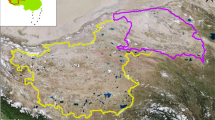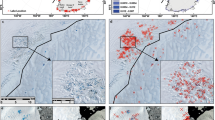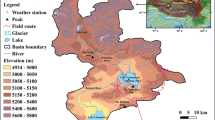Abstract
Understanding the changes in number and areal extent of lakes, as well as their abundance and size distribution is important for assessments of regional and global water resources, biogeochemical cycles, and changes in climate. In this study, changes in lake area greater than 1 km2 are mapped using Landsat datasets, spanning the 1970s, 1990, 2000, and 2010. In addition, high-resolution images (GeoCover Landsat mosaic 2000, with a pixel size of 14.25 m) are used for the first time to map lakes as small as 0.001 km2 across the entire Tibetan Plateau (TP). Results show that the numbers and areal extent of individual lakes >1 km2 in size show a slight decrease between the 1970s and 1990, followed by a clear increase from 1990 to 2010. Ninety-nine new lakes are identified between the 1970s and 2010, 71 of which are found between 1990 and 2010. This indicates the accelerated glacier melt and/or increased difference of precipitation minus evaporation since the 1990s. More than 80 % of the lakes show an increase in their area between the 1970s and 2010. The lake census, using 2000 imagery, shows that there are 32,843 lakes with a total area of 43,151.08 ± 411.49 km2, which makes up 1.4 % of the total area of the TP. Around 96 % of all lakes are small, with an area <1 km2, while the 1,204 large lakes (>1 km2) account for 96 % of the total lake area. The TP is subdivided into 12 greater drainage basins, and of these the inner TP dominates in terms of the number of lakes (55.03 %), the total area of lakes (66 %), and lake density (0.026/km2 compared to the mean, 0.011/km2). A plot of lake abundance against size shows that the size distribution of lakes departs from a typical power-law distribution, but displays such a distribution at the mean elevation (4,715 m), with an r 2 value of 0.97 and a slope of −0.66. The slopes of the abundance-size equations from each of the 12 greater basins, and from all basins together, are larger than −1, supporting the inference that larger lakes, rather than the small lakes, contribute more to the total lake surface area across the TP. The lake inventory provided in this study, along with the assessment of lake size distribution, have important implications for estimates of water balance, for water resource management, and for lake area estimations in the TP.








Similar content being viewed by others
References
Krinner G (2003) Impact of lakes and wetlands on boreal climate. J Geophys Res 108:4520
Cole JJ, Prairie YT, Caraco NF et al (2007) Plumbing the global carbon cycle: integrating inland waters into the terrestrial carbon budget. Ecosystems 10:172–185
Tranvik LJ, Downing JA, Cotner JB et al (2009) Lakes and reservoirs as regulators of carbon cycling and climate. Limnol Oceanogr 54:2298–2314
Lehner B, Döll P (2004) Development and validation of a global database of lakes, reservoirs and wetlands. J Hydrol 296:1–22
Seekell DA, Pace ML, Tranvik LJ et al (2013) A fractal-based approach to lake size-distributions. Geophys Res Lett 40:517–521
McDonald CP, Rover JA, Stets EG et al (2012) The regional abundance and size distribution of lakes and reservoirs in the United States and implications for estimates of global lake extent. Limnol Oceanogr 57:597–606
Downing JA, Prairie Y, Cole J et al (2006) The global abundance and size distribution of lakes, ponds, and impoundments. Limnol Oceanogr 51:2388–2397
Seekell DA, Pace ML (2011) Does the Pareto distribution adequately describe the size-distribution of lakes? Limnol Oceanogr 56:350–356
Balcerak E (2013) How many lakes are there, and how big are they? Eos Trans Amer Geophys Union 94:104–214
Lewis WM (2011) Global primary production of lakes: 19th Baldi Memorial Lecture. Inland Waters 1:1–28
Meybeck M (1995) Global distribution of lakes. In: Vorosmarty C (ed) Physics and chemistry of lakes. Springer, Heidelberg, pp 1–35
Yao T, Thompson L, Yang W et al (2012) Different glacier status with atmospheric circulations in Tibetan Plateau and surroundings. Nat Clim Change 2:663–667
Gardner AS, Moholdt G, Cogley JG et al (2013) A reconciled estimate of glacier contributions to sea level rise: 2003–2009. Science 340:852–857
Liu XD, Chen BD (2000) Climatic warming in the Tibetan Plateau during recent decades. Int J Climatol 20:1729–1742
Zhang G, Xie H, Duan S et al (2011) Water level variation of Lake Qinghai from satellite and in situ measurements under climate change. J Appl Remote Sens 5:053532
Zhang G, Xie H, Kang S et al (2011) Monitoring lake level changes on the Tibetan Plateau using ICEsat altimetry data (2003–2009). Remote Sens Environ 115:1733–1742
Zhang G, Xie H, Yao T et al (2012) Snow cover dynamics of four lake basins over Tibetan Plateau using time series MODIS data (2001–2010). Water Resour Res 48:W10529
Zhang G, Yao T, Xie H et al (2013) Increased mass over the Tibetan Plateau: from lakes or glaciers? Geophys Res Lett 40:2125–2130
Zhang G, Xie H, Yao T et al (2013) Water balance estimates of ten greatest lakes in China using ICEsat and Landsat data. Chin Sci Bull 58:3815–3829
Phan VH, Lindenbergh R, Menenti M (2012) Icesat derived elevation changes of Tibetan lakes between 2003 and 2009. Int J Appl Earth Obs Geoinf 17:12–22
Wang X, Gong P, Zhao Y et al (2013) Water-level changes in China’s large lakes determined from ICESat/GLAS data. Remote Sens Environ 132:131–144
Sun F, Zhao Y, Gong P et al (2013) Monitoring dynamic changes of global land cover types: fluctuations of major lakes in China every 8 days during 2000–2010. Chin Sci Bull 59:171–189
Yang K, Ye B, Zhou D et al (2011) Response of hydrological cycle to recent climate changes in the Tibetan Plateau. Clim Change 109:517–534
Lei Y, Yao T, Bird BW et al (2013) Coherent lake growth on the central Tibetan Plateau since the 1970s: characterization and attribution. J Hydrol 483:61–67
Hanson PC, Carpenter SR, Cardille JA et al (2007) Small lakes dominate a random sample of regional lake characteristics. Freshw Biol 52:814–822
Ma R, Yang G, Duan H et al (2011) China’s lakes at present: number, area and spatial distribution. Sci China Earth Sci 54:283–289
Wang SM, Dou HS (1998) Chinese lakes inventory. Institute of Geography and Limnology, Beijing
Ma R, Duan H, Hu C et al (2010) A half-century of changes in China’s lakes: global warming or human influence? Geophys Res Lett 37:24106
Zhu D, Meng X, Zheng D et al (2007) Changes of rivers and lakes on the Qinghai-Tibet Plateau in the past 25 years and their influence factors. Geol Bull Chin 26:22–30
Yao T, Pu J, Lu A et al (2007) Recent glacial retreat and its impact on hydrological processes on the Tibetan Plateau, China, and surrounding regions. Arctic Antarctic Alpine Res 39:642–650
Zhu LP, Xie MP, Wu YH (2010) Quantitative analysis of lake area variations and the influence factors from 1971 to 2004 in the Nam Co basin of the Tibetan Plateau. Chin Sci Bull 55:1294–1303
Nie Y, Zhang Y, Ding M et al (2013) Lake change and its implication in the vicinity of Mt. Qomolangma (Everest), central high Himalayas, 1970–2009. Environ Earth Sci 68:251–265
Song C, Huang B, Ke L (2013) Modeling and analysis of lake water storage changes on the Tibetan Plateau using multi-mission satellite data. Remote Sens Environ 135:25–35
Farr TG, Rosen PA, Caro E et al (2007) The Shuttle Radar Topography Mission. Rev Geophys 45:4001
Valeriano MM, Kuplich TM, Storino M et al (2006) Modeling small watersheds in Brazilian Amazonia with Shuttle Radar Topographic Mission-90 m data. Comput Geosci 32:1169–1181
Tucker CJ, Grant DM, Dykstra JD (2004) NASA’s global orthorectified Landsat data set. Photogramm Eng Remote Sens 70:313–322
Koeln G, Dykstra J, Cunningham J (1999) Geocover and geocover-lc: orthorectified Landsat TM/MSS data and derived land cover for the world. In: Proceedings of international symposium on digital earth, Western Australia University, Crawley 23–25 August 1999
USGS (2004) Phase 2 gap-fill algorithm: slc-off gap-filled products gap-fill algorithm methodology. Landsat.usgs.gov/documents/L7SLCGapFilledMethod.pdf. Accessed 10 Aug 2013
Verpoorter C, Kutser T, Tranvik L (2012) Automated mapping of water bodies using Landsat multispectral data. Limnol Oceanogr 10:1037–1050
Feyisa GL, Meilby H, Fensholt R et al (2014) Automated water extraction index: a new technique for surface water mapping using landsat imagery. Remote Sens Environ 140:23–35
Xu H (2006) Modification of normalised difference water index (NDWI) to enhance open water features in remotely sensed imagery. Int J Remote Sens 27:3025–3033
Fujita K, Sakai A, Nuimura T et al (2009) Recent changes in Imja glacial lake and its damming moraine in the Nepal Himalaya revealed by in situ surveys and multi-temporal ASTER imagery. Environ Res Lett 4:045205
Salerno F, Thakuri S, D’Agata C et al (2012) Glacial lake distribution in the Mount Everest region: uncertainty of measurement and conditions of formation. Glob Planet Change 92:30–39
Hamilton SK, Melack JM, Goodchild MF et al (1992) Estimation of the fractal dimension of terrain from lake size distributions. In: Lewis WM (ed) Lowland floodplain rivers: geomorphological perspectives. Wiley, Chichester, pp 145–163
Goodchild MF (1998) Lakes on fractal surfaces: a null hypothesis for lake-rich landscapes. Math Geol 20:615–630
Bolch T, Yao T, Kang S et al (2010) A glacier inventory for the western Nyainqêntanglha range and Nam Co basin, Tibet, and glacier changes 1976–2009. Cryosphere 4:419–433
Kang SC, Chen F, Ye QH et al (2007) Glacier retreating dramatically on the Mt. Nyainqêntanglha during the last 40 years. J Glaciol Geocryol 29:869–873 (in Chinese)
Yao T, Li Z, Yang W et al (2010) Glacial distribution and mass balance in the Yarlung Zangbo River and its influence on lakes. Chin Sci Bull 55:2072–2078
Xu ZX, Gong TL, Li JY (2008) Decadal trend of climate in the Tibetan Plateau—regional temperature and precipitation. Hydrol Process 12:3056–3065
Zhou S, Kang S, Chen F et al (2013) Water balance observations reveal significant subsurface water seepage from lake Nam Co, south-central Tibetan Plateau. J Hydrol 491:89–99
Bian D, Du J, Hu J et al (2009) Response of the water level of the Yamzho Yumco to climate change during 1975–2006. J Glaciol Geocryol 31:404–409 (in Chinese)
Liu-Zeng J, Tapponnier P, Gaudemer Y et al (2008) Quantifying landscape differences across the Tibetan Plateau: implications for topographic relief evolution. J Geophys Res 113:F04018
Liu J, Ding L, Zeng L et al (2006) Large-scale terrain analysis of selected regions of the Tibetan Plateau: discussion on the origin of plateau planation surface. Earth Sci Front 13:285–299
Chen Y, Zong Y, Li B et al (2013) Shrinking lakes in Tibet linked to the weakening asian monsoon in the past 8.2 ka. Quat Res 80:189–198
Xu W, Florian S, Ai-guo Z et al (2013) Glacier and glacial lakes changes and their relationship in the context of climate change, central Tibetan Plateau 1972–2010. Glob Planet Change 111:246–257
Li J, Sheng Y (2012) An automated scheme for glacial lake dynamics mapping using landsat imagery and digital elevation models: a case study in the Himalayas. Int J Remote Sens 33:5194–5213
Wang W, Yao T, Yang W et al (2012) Methods for assessing regional glacial lake variation and hazard in the southeastern Tibetan Plateau: a case study from the Boshula mountain range, China. Environ Earth Sci 67:1441–1450
Acknowledgements
This work was supported by the National Natural Science Foundation of China (41301063, 41190081, and 31228021), and the Strategic Priority Research Program (B) of the Chinese Academy of Sciences (XDB01020300). Landsat GeoCover moisaics provided by the University of Maryland’s Global Land Cover Facility (http://glcf.umd.edu/data/mosaic/), Landsat TM/ETM+ from Geospatial Data Cloud, Computer Network Information Center, Chinese Academy of Sciences at http://www.gscloud.cn and USGS at http://glovis.usgs.gov/ were sincerely acknowledged.
Author information
Authors and Affiliations
Corresponding author
About this article
Cite this article
Zhang, G., Yao, T., Xie, H. et al. Lakes’ state and abundance across the Tibetan Plateau. Chin. Sci. Bull. 59, 3010–3021 (2014). https://doi.org/10.1007/s11434-014-0258-x
Received:
Accepted:
Published:
Issue Date:
DOI: https://doi.org/10.1007/s11434-014-0258-x




